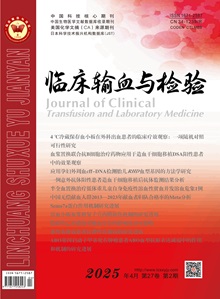|
|
Early Clinical Efficacy and Safety Analysis of Cladribine Combined with Venetoclax and Low-dose Cytarabine in Elderly AML Patients
WANG Anyou, ZHU Ting, Wang LI, et al
JOURNAL OF CLINICAL TRANSFUSION AND LABORATORY MEDICINE
2023, 25 (4):
539-543.
DOI: 10.3969/j.issn.1671-2587.2023.04.021
Objective This study aimed to explore the early clinical efficacy and safety of cladribine combined with venetoclax and low-dose cytarabine in elderly patients with acute myeloid leukemia (AML) by small sample analysis.
Methods From September 2022 to March 2023, 12 newly diagnosed and refractory elderly AML patients in our center were selected as the study subjects. All patients were treated with cladribine combined with venetoclax+low-dose cytarabine for the first induction chemotherapy. The clinical efficacy was evaluated after 1~2 cycles of chemotherapy; the safety data was collected and analyzed during the first induction chemotherapy process, and the bone marrow suppression and non hematological toxicity of this protocol were evaluated in elderly AML patients undergoing induction therapy.
Results After 1~2 cycles of treatment, 12 patients achieved complete clinical remission (CR+CRi 83.3%,10/12), except for 2 patients who did not follow up with bone marrow due to the epidemic and personal reasons after the first course of treatment. No deaths occurred during the induction chemotherapy period; During that period, the patient had good tolerance and was hospitalized for an average of 27.8 days. During the hospitalization period, the main manifestations were hematological toxicity and bone marrow suppression. The average days of neutrophil ratio below 0.5×10
9/L, platelet count below 20×10
9/L, and hemoglobin below 60 g/L were 12.7 days, 10.6 days, and 10.8 days, respectively. Among them, 2 patients had severe pulmonary infections before induction chemotherapy, and after actively and stably controlling the infection, this regimen was administered for induction chemotherapy, During chemotherapy, the infection did not worsen on the basis of continuous treatment.
Conclusion This protocol has a better therapeutic effect in the induction therapy of elderly AML, and has a significant improvement compared to the current demethylation combined with Vineclavone protocol in elderly AML patients. The efficacy is basically consistent with recent reports abroad, with a high early clinical remission rate and tolerability. There are no deaths during the initial induction chemotherapy period, and all patients have controllable hematological and non hematological toxicity, which is worthy of further clinical promotion and application.
Reference |
Related Articles |
Metrics
|
|
